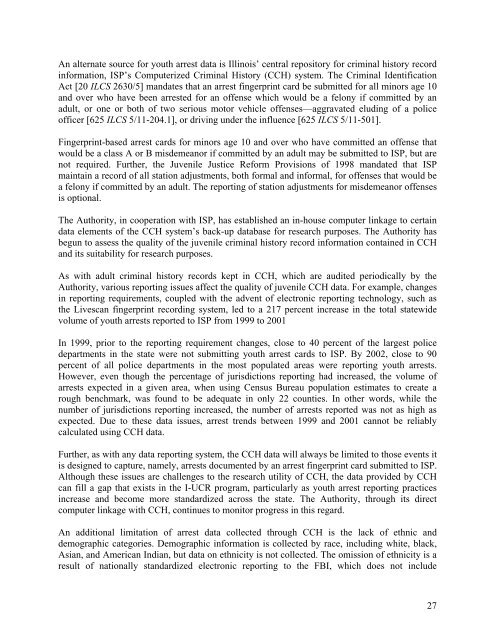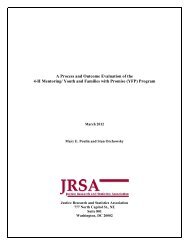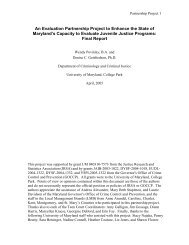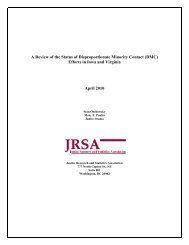Juvenile Justice System and Risk Factor Data - Illinois Criminal ...
Juvenile Justice System and Risk Factor Data - Illinois Criminal ...
Juvenile Justice System and Risk Factor Data - Illinois Criminal ...
You also want an ePaper? Increase the reach of your titles
YUMPU automatically turns print PDFs into web optimized ePapers that Google loves.
An alternate source for youth arrest data is <strong>Illinois</strong>’ central repository for criminal history record<br />
information, ISP’s Computerized <strong>Criminal</strong> History (CCH) system. The <strong>Criminal</strong> Identification<br />
Act [20 ILCS 2630/5] m<strong>and</strong>ates that an arrest fingerprint card be submitted for all minors age 10<br />
<strong>and</strong> over who have been arrested for an offense which would be a felony if committed by an<br />
adult, or one or both of two serious motor vehicle offenses—aggravated eluding of a police<br />
officer [625 ILCS 5/11-204.1], or driving under the influence [625 ILCS 5/11-501].<br />
Fingerprint-based arrest cards for minors age 10 <strong>and</strong> over who have committed an offense that<br />
would be a class A or B misdemeanor if committed by an adult may be submitted to ISP, but are<br />
not required. Further, the <strong>Juvenile</strong> <strong>Justice</strong> Reform Provisions of 1998 m<strong>and</strong>ated that ISP<br />
maintain a record of all station adjustments, both formal <strong>and</strong> informal, for offenses that would be<br />
a felony if committed by an adult. The reporting of station adjustments for misdemeanor offenses<br />
is optional.<br />
The Authority, in cooperation with ISP, has established an in-house computer linkage to certain<br />
data elements of the CCH system’s back-up database for research purposes. The Authority has<br />
begun to assess the quality of the juvenile criminal history record information contained in CCH<br />
<strong>and</strong> its suitability for research purposes.<br />
As with adult criminal history records kept in CCH, which are audited periodically by the<br />
Authority, various reporting issues affect the quality of juvenile CCH data. For example, changes<br />
in reporting requirements, coupled with the advent of electronic reporting technology, such as<br />
the Livescan fingerprint recording system, led to a 217 percent increase in the total statewide<br />
volume of youth arrests reported to ISP from 1999 to 2001<br />
In 1999, prior to the reporting requirement changes, close to 40 percent of the largest police<br />
departments in the state were not submitting youth arrest cards to ISP. By 2002, close to 90<br />
percent of all police departments in the most populated areas were reporting youth arrests.<br />
However, even though the percentage of jurisdictions reporting had increased, the volume of<br />
arrests expected in a given area, when using Census Bureau population estimates to create a<br />
roug h benchmark, was found to be adequate in only 22 counties. In other words, while the<br />
number of jurisdictions reporting increased, the number of arrests reported was not as high as<br />
expected. Due to these data issues, arrest trends between 1999 <strong>and</strong> 2001 cannot be reliably<br />
calculated using CCH data.<br />
Further, as with any data reporting system, the CCH data will always be limited to those events it<br />
is designed to capture, namely, arrests documented by an arrest fingerprint card submitted to ISP.<br />
Although these issues are challenges to the research utility of CCH, the data provided by CCH<br />
can fill a gap that exists in the I-UCR program, particularly as youth arrest reporting practices<br />
increase <strong>and</strong> become more st<strong>and</strong>ardized across the state. The Authority, through its direct<br />
computer linkage with CCH, continues to monitor progress in this regard.<br />
An additional limitation of arrest data collected through CCH is the lack of ethnic <strong>and</strong><br />
demographic categories. Demographic information is collected by race, including white, black,<br />
Asian, <strong>and</strong> American Indian, but data on ethnicity is not collected. The omission of ethnicity is a<br />
result of nationally st<strong>and</strong>ardized electronic reporting to the FBI, which does not include<br />
27

















